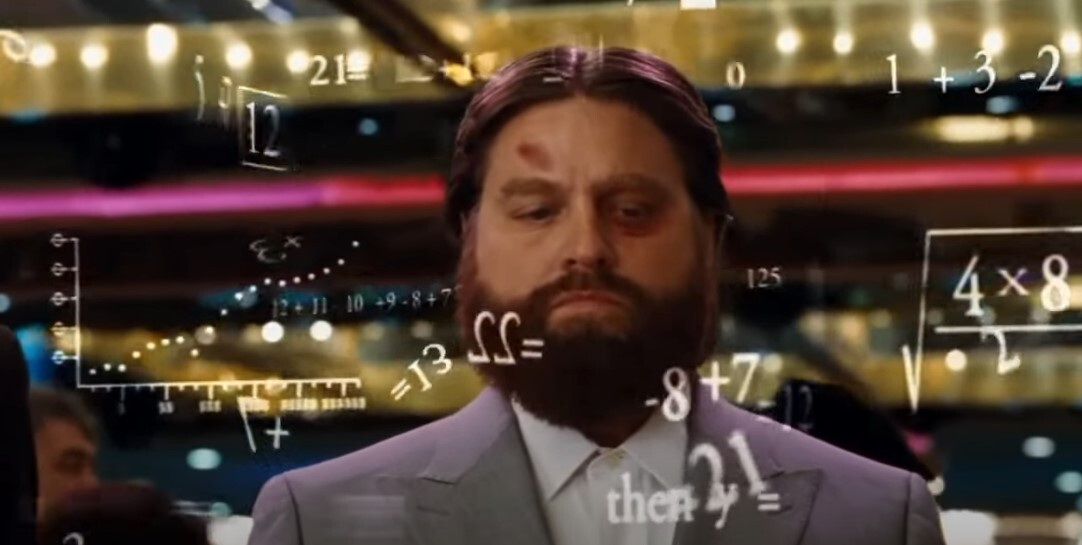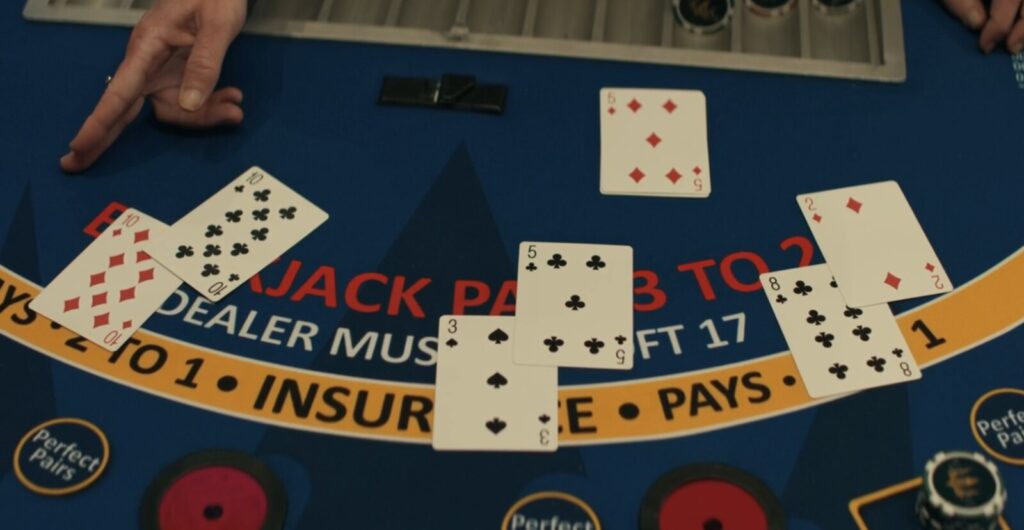I was watching the Amazon Prime show Reacher the other day when I noticed an inaccuracy that’s misrepresented across so much media that the popular understanding of how it works has become pretty much roundly incorrect. What I’m talking about is the idea of “counting cards” in blackjack. In Reacher, it’s used, as it often is, to show that some character is a certified math genius. The character Karla Dixon is shown sitting at the blackjack table pictured below, and from there, it’s a quick deluge of nonsense.
To my delight, we can see all the cards in play, which means I can be a real asshole about it.
Dixon is playing three hands at a time, I guess because they were worried her brain wasn’t big enough. She issues the command to the dealer, “Stand.” The dealer replies, “Ma’am, you’re showing ten and eight on two of your hands.” Dixon acknowledges that the dealer is right, and she should double down, but then explains: “That’s right. And I could double down and risk it all for a potentially larger payout. Or, I could stand, and have a guaranteed win because the next card out of that shoe is gonna bust you.”
Sure enough, the dealer receives a face card and busts, to the adulation of the crowd. This idea, that a card counter knows “the next card out of that shoe” (shoe being the card holder casino dealers draw from) is patently false. Movies, though, have put the idea in the public’s head that a successful card counter can all but list off the series of upcoming cards, knowing their specific position in the deck. The scene from Rain Man where Tom Cruise’s character realizes his brother, Raymond, knows that “lots and lots of” queens are left in a deck might be the biggest source of this misunderstanding.
Interestingly enough, I don’t think Rain Man’s portrayal of card counting was that inaccurate — it was just misinterpreted. Sure, there’s some tangential gaffes we can chalk up to functional storytelling, like the fact that there’s no way Raymond could have established a count immediately upon sitting down at a new table, or that casinos generally frown upon someone sitting next to you giving you advice (at least when you’re winning.) But having an idea of how many face cards remain in the deck(s) is central to card counting. There’s just a lot more chance involved than people think. The mythical card counter never loses a hand, while real card counting simply tips the odds in the players’ favor over time.
To that end here’s how a very basic card-counting actually works: Each card is assigned a value, which you add up on each hand, keeping a running tally. A common system is that you subtract one for cards between 2 and 6, add one for 10s and face cards and don’t adjust for 7 through 9. Meaning also that you don’t need to be nearly as smart as you think to count cards, though please don’t take that as a challenge. No advanced statistics or floating equations needed, just basic addition and subtraction and a decent memory.
A high count means there aren’t many tens and face cards left, and a low count means there are disproportionately more 10s and face cards. More complex counting systems exist, but none of them will ever tell you what specific cards are or where they are. They just give a more precise idea of the general value composition of the remaining deck.

Another big divergence from popular belief? The count isn’t primarily for the purpose of affecting how you play the hands you’re dealt. Sure, if you know there’s more low cards, you might take a risk on an inadvisable hit, but that’s secondary to the larger picture. Which is that lots of high cards provide an advantage to the player thanks to a higher probability of blackjack, with its premium payout (often 3:2 instead of even odds), and a higher probability of the dealer going bust.
Card counters will bet more per hand when they have this advantage, and bet smaller amounts when the deck is full of low cards, which is an advantage for the dealer. Applied properly over time, this can turn what’s a small house edge into a statistical edge for the player. One that, in a six-deck shoe like in Rain Man, comes out to a whopping one percent.
Hey, I get it, no one wants to watch Tom Cruise grind out a 51 percent win-rate for hours on end.
Moreover, that’s all assuming that a casino, who you can bet your sweet caboose knows all about card counting, hasn’t put in place measures to stop it. Automatic shufflers make it impossible, and reshuffling/changing decks halfway or less through a shoe make it incredibly difficult to establish a useful count — if you’re even allowed to continue playing.
That brings me to another often-coupled myth, which Reacher also includes, just to enhance my forehead vein’s protrusion. When a casino employee informs Dixon that they know she’s counting cards, she snappily replies, “Which isn’t illegal, as long as I do it in my head.”
This is true. It’s also true that casinos are private property, meaning that if they ask you to leave and you refuse, they’ll slap you with a trespassing charge instead.

